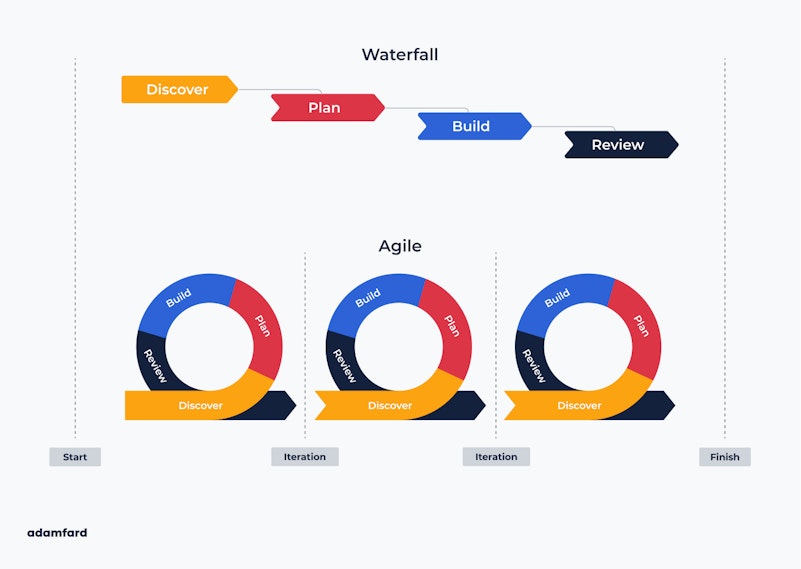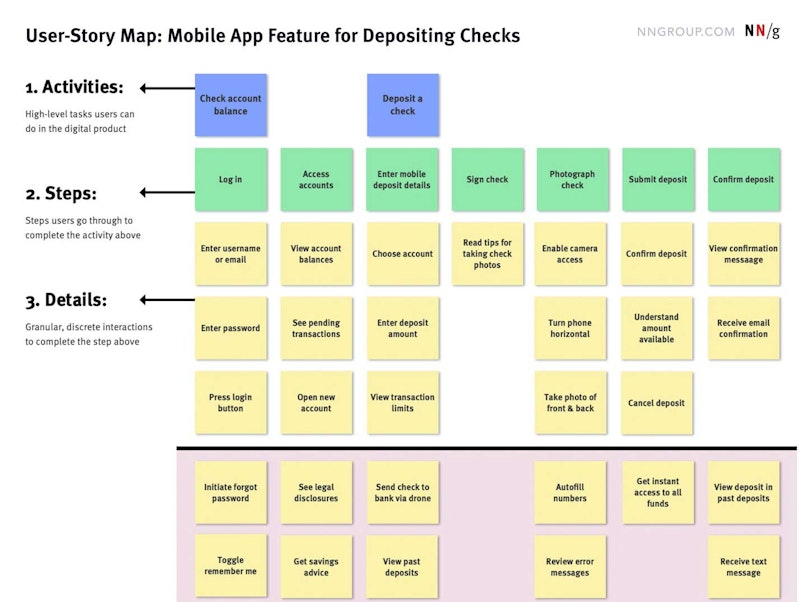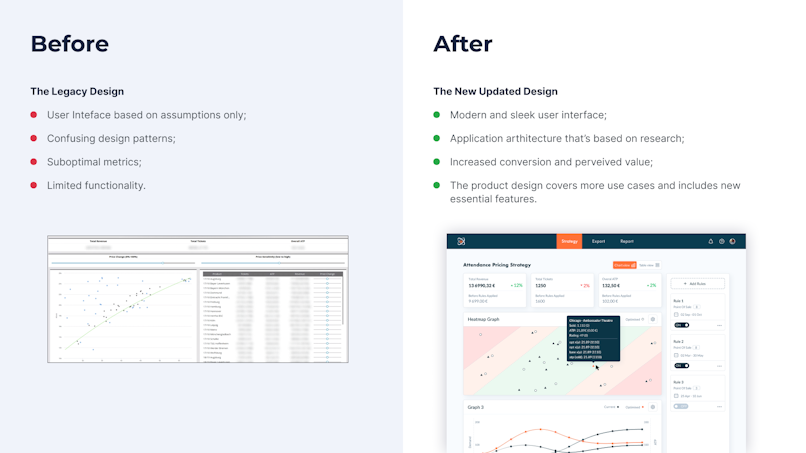About 20 years ago, Agile was merely a set of management practices aimed at developers. In 2020, however, it’s much more than just that. Agile has permeated a multitude of different types of organizations, teams, and crafts.
An important field that has been influenced by this methodology is design. Today, companies all around the world use it as a framework for establishing how their products should look and feel. It’s called Agile design.
In this article, we’ll take a look at how your team can incorporate Agile principles in design and user experience work.
Here goes!

Get an express UX Audit. Done in 24 hours.
Submit designs. Get a review the next day. It's that simple.
Try nowSo what is Agile?

Agile is a people-oriented management system, designed to make teams much more adaptable to changes. It appeared as a response to the then-popular Waterfall methodology, which has its fair share of shortcomings. It’s considered to be clunky and unforgiving, among other things.

Agile intended to change the focus from rigid processes and orient it towards “authentic human interactions.”
The methodology revolves around four essential values:
Individuals and interactions > processes and tools;
Good software > detailed documentation;
Collaborating with customers > negotiating contracts;
Adapting to change > following rigid plans;
Why is Agile so popular?
Probably the most critical aspect of this methodology is that it’s iterative and evolutionary. It allows teams to improve the product with each iteration.
More importantly, teams can decide what improvements need to be made on each short iteration. As a result, the development process is both quick and rational — it addresses the most pressing issues immediately.
Plus, regular communication is a crucial aspect of the process too. Agile enables stakeholders and clients to provide teams with regular feedback. This is what sets this methodology apart from other approaches.
According to a study published by PwC, projects executed within an Agile methodology are nearly 30% more successful.
Agile Design Process, i.e. How To Apply Agile to Design
For a very long time, design has not been perceived as an iterative process. Often, designers would be pushed to start working on high-fidelity prototypes straight away. This often resulted in poorly thought out products that didn’t really address users’ needs adequately.
The Agile design process, on the other hand, is an iterative approach. Here’s a basic layout of the process:
Understand, Research, Sketch, Design, Prototype, Test, Refine
This approach allows designers to go beyond “just creating a product.” Instead, they’re able to improve a product’s design with each iteration and solve important problems. This will, as a result, lead to better user experience and customer satisfaction.

Also, Agile is comfortable with uncertainty. It’s important that teams embrace the so-called “unknown.” They need to accept that there are many questions that they don’t have answers to at this point. These answers will emerge as the design process continues in short iterations. This way, teams can continuously make small but very rational decisions.
Read more about Lean UX.
Interestingly, a principle that makes Agile product design efficient is called “Just Barely Good Enough.” The designs that teams deliver at the end of an iteration need to be somewhere between ideal and realistic. This reflects the very nature of this methodology.

You’re not trying to deliver a perfect product straight away. In Agile, steady and meaningful progress is more important than perfection.
Agile is iterative. Design is iterative. Why couldn't they work together?
— Jeff Gothelf
Agile Design Methodology: Benefits and Conditions
Naturally, Agile design has a broad spectrum of benefits. However, there are also some important conditions that need to be met to make things work.
Benefits:
Clients are more involved and provide teams with valuable feedback at all steps of the process;
An iterative process both allows to identify problems and respond to them very quickly;
Receiving regular feedback helps teams stay motivated and feel productive. Both are essential for boosting team morale;
An iterative process allows for a more transparent environment;
Agile enables teams to solve critical and imminent issues instantly, which saves a lot of money and time. The further a bug or a design issue makes it in the development process — the more expensive it is to solve it.
Conditions:
Abstain from rushing things. We often tend to be perfectionists, but Agile isn’t about reaching perfection instantly.
Because Agile operates in sprints, managers must abstain from micromanaging team members. It’s essential to learn to trust your colleagues and their expertise. This methodology is all about self-organizing.
Despite the fact that micromanagement is detrimental to Agile, it still demands a leader position. This person is responsible for keeping the team on track;
It’s essential to establish when the job is done. One of the pitfalls of Agile is that it can continue reiterating the product endlessly. However, there is a moment when it becomes counterproductive.
Be prepared to take criticism — a lot of it. Adopting an Agile approach towards design implies involving your clients in all the phases of the design process. This way, they get a better understanding of what their product will look like, and you lower your chances of unpleasant surprises.
“Always be testing.” An essential part of designing in an Agile spirit is testing things as frequently as possible. Designers need to break large problems into smaller ones and test possible solutions.
Deeper Dive into Agile Practices
Ready to dive deeper into the nitty-gritty of Agile? Let's explore some key practices that can transform your design and development process.
User Story Mapping
User Story Mapping is a powerful way to break down complex user stories into smaller, more manageable tasks. It helps visualize the user journey and prioritize work.
Here's a basic approach:
Identify User Goals: What do users want to achieve with your product or service?
Create User Stories: Write concise user stories that describe a specific user goal.
Map User Stories to a Timeline: Arrange user stories on a timeline to represent the user's journey.
Break Down User Stories: Divide each user story into smaller tasks, known as user story cards.
Estimate Story Points: Assign a relative size or complexity estimate to each user story card.

Sprint Planning
Sprint planning is an important part of the Agile process where the team plans the work for the upcoming sprint. The key steps involved in sprint planning are:
Review the Product Backlog: The product backlog is a prioritized list of user stories.
Select User Stories: Choose a subset of user stories that can be completed within the sprint timeframe.
Break Down User Stories: Break down selected user stories into smaller tasks.
Estimate Work: Estimate the effort required to complete each task.
Create a Sprint Backlog: Create a prioritized list of tasks for the sprint.
Define the Sprint Goal: Set a clear and concise goal for the sprint.

Daily Stand-ups
Daily stand-ups are short, daily meetings that help team members synchronize their work and identify any blockers. The key principles of a successful daily stand-up are:
Keep it Short: Aim for a 15-minute time limit.
Answer Three Questions: What did I do yesterday? What will I do today? What obstacles are in my way?
Focus on Progress: Discuss progress made, any impediments encountered, and what's planned for the day.
Keep it Focused: Avoid going off on tangents or discussing complex problems in detail.
Sprint Reviews and Retrospectives
Sprint reviews and retrospectives are essential for continuous improvement.
Sprint review
The Sprint Review helps you demonstrate the work completed during the sprint. You also get to gather feedback from stakeholders and customers and identify areas for improvement.
Sprint Retrospective
This is about reflecting on the past sprint to identify what went well, what went wrong, and what can be improved. Also, the team makes actionable commitments for the next sprint.
With these Agile practices, teams can improve their productivity, quality, and customer satisfaction.
Practical Tips for Implementing Agile Design
Now that you understand the fundamentals, how about some practical tips for succeeding in Agile design? Let's cover that in this section.
Effective Communication: The Heart of Agile
Clear and open communication is the lifeblood of any Agile team. Here are some tips to ensure effective communication:
Daily Stand-ups: These short, daily meetings help keep everyone aligned and informed about the team's progress.
Regular Retrospectives: Dedicate time to reflect on what went well, what didn't, and how to improve future sprints.
Transparent Backlogs: Maintain a visible product backlog to ensure shared understanding and alignment.
Active Listening: Encourage active listening during meetings and discussions to foster empathy and collaboration.
Clear and Concise Communication: Use plain language and avoid jargon to ensure everyone is on the same page.
Through effective communication, you can build strong relationships, resolve issues quickly, and deliver high-quality products.
Keeping Score: Agile Metrics That Matter
Want to know if your Agile team is hitting its stride? Tracking the right metrics can help you measure progress and identify areas for improvement.
Here are a few key metrics to keep an eye on:
Velocity: How much work can your team typically churn out in a sprint?
Lead Time: How long does it take to get a feature from idea to customer?
Cycle Time: How quickly can your team complete a single task?
Defect Density: How many bugs are creeping into your code?
Customer Satisfaction: Are your customers happy with the final product?
These metrics, when tracked properly, can help you spot trends, identify bottlenecks, and make data-driven decisions to optimize your Agile process.
Remember: While metrics are important, don't let them become the sole focus. The ultimate goal of Agile is to deliver value to customers, so don't forget to balance your metrics with qualitative feedback and customer satisfaction.
Overcoming Common Agile Challenges
While Agile is a powerful methodology, it's not without its challenges. And to fully succeed as an Agile team, there are some factors to note and prepare for.
Here are common hurdles and how to overcome them:
Scope Creep: Keeping Your Project on Track
Scope creep happens when new features or requirements are added without proper planning.
Prioritization: Use feature prioritization frameworks like MoSCoW prioritization to focus on the most important features.
Regular Reviews: Conduct regular reviews to ensure the team is still aligned with the original goals.
Effective Communication: Clearly communicate priorities and expectations to all stakeholders.
Changing Priorities: Adapting to the Shifting Landscape
To stay agile, be prepared to adapt.
Flexible Planning: Use techniques like Agile Kanban to visualize and prioritize work.
Regular Re-prioritization: Review the product backlog regularly to adjust to changing priorities.
Effective Communication: Keep stakeholders informed of changes and the reasons behind them.
Resistance to Change: Building Buy-in and Overcoming Obstacles
Change can be scary, especially for teams used to traditional ways of working. To overcome resistance:
Education and Training: Provide training on Agile principles and practices to build understanding and buy-in.
Involve Stakeholders: Involve stakeholders in the Agile process to gain their support and input.
Start Small: Begin with a small pilot project to demonstrate the benefits of Agile.
Celebrate Successes: Recognize and reward team members for their contributions to Agile projects.
When teams fully understand and address these common challenges, they will end up successfully implementing Agile practices. This can lead to delivering high-quality products.
Case Study: Th!nkPricing — Agile Design for AI-Driven Pricing
Th!nkPricing, an AI SaaS platform optimizing dynamic pricing for industries like Sports, Cinema, and Ski Resorts, partnered with us to enhance user trust, usability, and scalability. Through an Agile UX process, we collaborated with stakeholders to address challenges like building trust in AI-generated pricing, creating intuitive workflows, and setting realistic expectations for data-driven optimization. The activities we carried out included UX workshops, iterative prototyping, usability testing, and refining brand aesthetics. We delivered a coding-ready design aligned with the client’s vision and user needs.
Key Outcomes:
Increased user trust in AI recommendations.
Higher retention rates, enabling confident marketing scaling.
A polished, coding-ready web app with a cohesive brand aesthetic.

Looking to hire an expert team experienced in agile processes? Reach out to our experts today.
The takeaway
Agile has proven to be an excellent approach to software development. There are few reasons why design teams shouldn’t adopt this methodology to make their work more productive and efficient.
More importantly, this approach to development enables both intra- and inter-team communication. By communicating efficiently, all the essential teams can reach solutions that increase the value of the product.

The Art of Launching a Product
Get Our Free E-book on Launching Products with the Agile Approach
Download Now




